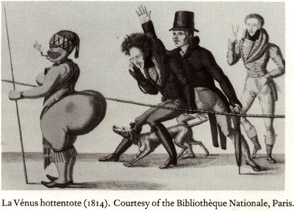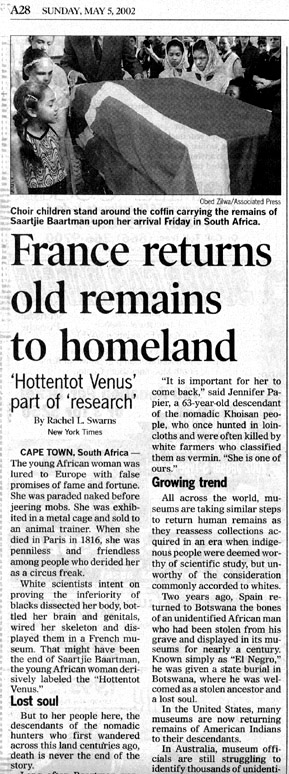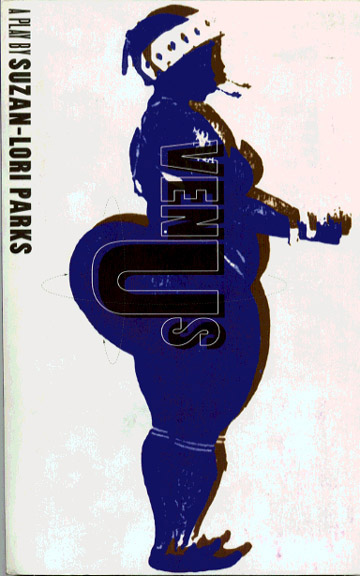

Welcome to the Venus Hottentot Community!
In conjunction with Black History Month in February 2003, ASU West's Interdisciplinary Arts Program produced a fantastic play, "Venus," by African American playwright Suzan-Lori Parks. IAP's Charles St. Claire directed a wonderful cast of actors. Several faculty members incorporated into their courses lessons about the Hottentot Venus, the understanding of which offers us a rich educational opportunity on many levels.
This site invited the ASU West community to join the Blackboard community and learn about the play "Venus" as well as the complex themes it addresses. This site puts you in touch with resources such as online links, news items, scholarly articles, images of the Venus Hottentot in its various permutations over the last two centuries.
NEW!
"'Venus,'
Black Tragedy Based on a True Story," by Samuel Trommler Jr.
Arizona Republic article
about the play, February 12, 2003 (outdated;
do a search on azcentral.com)
Web page with selected online sites related to the Hottentot Venus
Suzan-Lori Parks' play "Venus"
tackles a web of complex and fascinating topics relevant to a wide range
of contemporary critical interdisciplinary interests in popular culture and
scholarship. Its reach is both historical and due to recent events,
eminently current. In brief, the saga dates from 1810 when Sara Baartman
left colonial southern Africa to seek her fortune in Europe, only to find
herself billed as the "Venus Hottentot" and exhibited as an object of lascivious
fascination in the street fairs and private salons of London and Paris until
her death few years later. She next became an object of scientific racism
when the premier Parisian anatomist of the day dissected her body in his
attempt to contribute to the widespread effort to 'prove' the 'racial' inferiority
of Africans, as epitomized in the pejoratively named Hottentots (later Bushmen,
now Khoikhoi). A plaster cast of Baartman's body and preserved genitalia
remained on display in the Museé de l'Homme in Paris until the 1970s,
quietly reinforcing the ordered coherence of racist, misogynist, colonialist
conventions that undergirded her initial notoriety. Remarkably, she
again entered a patently current global circuit of political-cultural exchange
in April of 2002, when her remains were joyously repatriated to a post-apartheid
South Africa.
 A full genealogy tracking the multiple
permutations of the Venus Hottentot's image would readily disclose its cultural
and political resilience up to the present. The figure of Sara Baartman,
portrayed more infamously as Hottentot Venus, became a pervasive icon representing
Western perceptions of the essence of the colonial black female's exotic
sexualized Otherness. Like other Western cultural conventions of the representation
of human diversity from the 19th into the 21st centuries, the figure of the
Hottentot Venus, and the tale of Sara Baartman as interpreted by Suzan-Lori
Parks' play, offers us a focused opportunity not only to critically reexamine
a historical moment of ongoing salience, but also to undermine the still (or
perhaps, once again) familiar and all too prevalent cultural complex encoding
race, gender, sexuality, and empire.
A full genealogy tracking the multiple
permutations of the Venus Hottentot's image would readily disclose its cultural
and political resilience up to the present. The figure of Sara Baartman,
portrayed more infamously as Hottentot Venus, became a pervasive icon representing
Western perceptions of the essence of the colonial black female's exotic
sexualized Otherness. Like other Western cultural conventions of the representation
of human diversity from the 19th into the 21st centuries, the figure of the
Hottentot Venus, and the tale of Sara Baartman as interpreted by Suzan-Lori
Parks' play, offers us a focused opportunity not only to critically reexamine
a historical moment of ongoing salience, but also to undermine the still (or
perhaps, once again) familiar and all too prevalent cultural complex encoding
race, gender, sexuality, and empire.
NOTE: This was a self-enrolled Blackboard community for affiliates of ASU West during Spring 2003. It is no longer operating. As manager of this site, as well as dramaturg for the play, I invited instructors, students, and other users to join in the discussion shape the site.
Thanks for participating, Kristin Koptiuch
